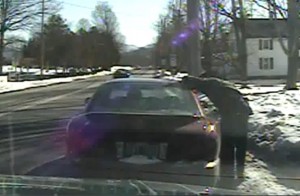News & Commentary
Nov 12, 2014
VT Police Militarization: Who Wants Sniper Rifles?
Since 1999, seven Vermont police agencies have applied to the federal Department of Defense's used military equipment giveaway program to obtain sniper rifles. The St. Johnsbury PD asked for a pair to watch over the town of 7,000. The Orange County sheriff's department also asked for two (the county's population is 29,000, which raises the question of what goes on in St. J. that doesn't go on in Orange County). And the PD in the Chittenden County suburb of Shelburne similarly asked for a pair. Shelburne is the image of peacefulness, with few or no known outbreaks of long-range combat (although the town does have, according to its application, approximately "4,000 tourists in during the season not counting camp residents"). The Lamoille County sheriff's department asked for two sniper rifles, and Brattleboro did, too -- along with 15 M-16 automatic assault rifles.

Sep 18, 2014
ACLUVT Files Suit Over Seizure of Motorist
The ACLU of Vermont has filed suit on behalf of a motorist who was stopped and had his car seized, leaving him stranded on the side of the road eight miles from his home in Rutland, because a state trooper said he smelled marijuana but otherwise had no evidence of a crime. At issue is not just an illegal traffic stop but whether police can continue to use a "sniff test" as evidence of a drug crime when possessing small quantities of the drug (marijuana) is no longer a crime.

Jun 10, 2014
Taser Bill Signed Into Law
Vermont's first-in-the-nation statewide Taser training and use bill was signed into law Tuesday by Gov. Peter Shumlin. The law, had it been in effect in 2012, would have prevented the police Taser death of her son, Macadam Mason, said Mason's mother, Rhonda Taylor at the Statehouse signing. She praised legislators, Gov. Shumlin and his administration, law enforcement, and civil rights and mental health advocates for getting the at-times contentious bill over the finish line.

May 12, 2014
2014 Legislative Wrap-Up
Significant strides were made this year in the legislature around a number of civil liberties issues. Check out our quick rundown of the high points (as well as some disappointments). Details for each bill can be found on our full legislative report.

Apr 11, 2014
Victory In Bogus Traffic Stop Case
Motorist Rod MacIver and the town of Shelburne have agreed to settle MacIver's case against police officer Jason Lawton on terms that take police oversight one step closer to reality for all Vermonters.

Nov 12, 2013
Police Shootings Must Stop
It is hard to imagine a civil society where government officials shoot their own citizens dead. It is harder still to imagine a civil society where government officials don't want to shoot their citizens dead, nevertheless do, yet don't have a plan to stop doing so.

Oct 11, 2013
Public Can See Police Discipline Records
In an important ruling for government transparency and accountability, the Vermont Supreme Court said Friday that the public has the right to see internal investigations of police officers suspected of misconduct. Shame and embarrassment aren't grounds to deny the public access to records that can shine a light on oversight and management of public employees, the court said.

Oct 01, 2013
Leahy Dogs Issue Of Checkpoints
Sen. Patrick Leahy has written the U.S. Department of Homeland Security asking for clarification of plans by the Border Patrol to build permanent internal checkpoints along major north-south Interstate highways in New England, including I-91 and I-89 in Vermont, according to the Valley News. The checkpoints would be miles from any international boundary -- but within the 100-mile zone the Border Patrol claims as its jurisdiction to stop motorists for no specific reason.

Sep 30, 2013
NSA Reaching Way Beyond Calls And E-mails
More information released by Edward Snowden and reported over the weekend by The New York Times shows that the NSA is tapping into "material from public, commercial and other sources, including bank codes, insurance information, Facebook profiles, passenger manifests, voter registration rolls and GPS location information, as well as property records and unspecified tax data." That information is added to our e-mails and phone call "metadata." From all these sources, the Times reports, is created a "portrait of an individual, one that is perhaps more complete and predictive of behavior than could be obtained by listening to phone conversations or reading e-mails, experts say."

Stay Informed
Sign up to be the first to hear about how to take action.
By completing this form, I agree to receive occasional emails per the terms of the ACLU’s privacy statement.
By completing this form, I agree to receive occasional emails per the terms of the ACLU’s privacy statement.
